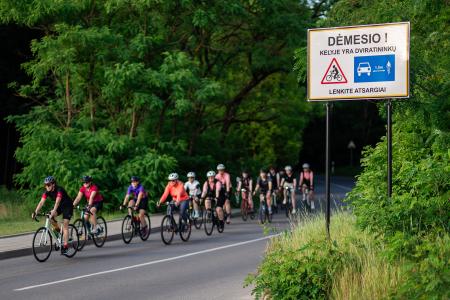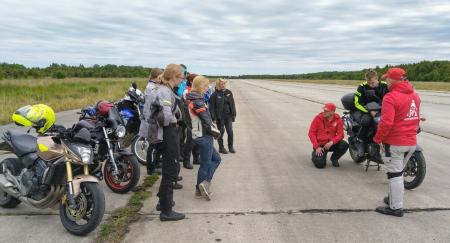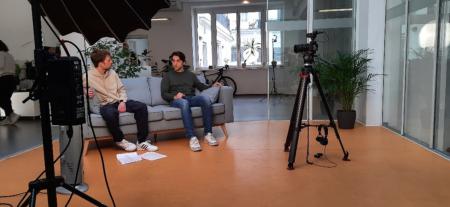Education in school or in community organizations

Saturday, June 15, 2024
The main road safety challenge that was tackled in this initiative is safety of the pedestrians and drivers on the main street of Põlva. The daily traffic volume on this road segment is high, with approximately 5000 vehicles, including trucks, passing through it every day. Simultaneously, high number of pedestrians use the same road daily to get to work or school. From a traffic safety perspective, this road segment is challenging – the hilly and winding road can distract drivers from speed limits, and the increased prevalence of light vehicles (bicycles, scooters etc) further amplifies the danger of this situation.
Smart Road is a vision of the future street, where all road users are equally preferred, and the emphasis is no longer solely on cars. Smart Road is designed to encourage drivers to objectively consider their traffic behaviour and to pay more attention to vulnerable road users. At the same time, the creators of Smart Road understand that vulnerable road users are indeed more difficult to notice, and effective solutions must be provided to assist drivers in focusing their attention on them.
Smart Road is a vision of the future street, where all road users are equally preferred, and the emphasis is no longer solely on cars. Smart Road is designed to encourage drivers to objectively consider their traffic behaviour and to pay more attention to vulnerable road users. At the same time, the creators of Smart Road understand that vulnerable road users are indeed more difficult to notice, and effective solutions must be provided to assist drivers in focusing their attention on them.

Friday, June 14, 2024
El desafío es implementar una iniciativa que permite mejorar y poner en práctica acciones que reduzcan los enclaves de concentración de accidentes, recogiendo el propósito de “Avanzar juntos hacia una movilidad segura”, compartiendo y comprometiéndonos a conseguir unos objetivos, desarrollando unas actividades que permite abordar con éxito el problema de la seguridad vial urbana en la Ciudad de Madrid, la segunda Ciudad Europea con mayor población.

Friday, June 14, 2024
Since 2017, the Croatian Automobile Club (HAK) has been implementing the educational and preventive program "KLIK - seat belt, a habit of responsible behavior" as part of the National Road Safety Plan of the Republic of Croatia, whose target group is senior high school students. The word “KLIK” is an acronym for “how to easily avoid a disaster” (in Croatian Kako Lako Izbjeći Katastrofu) and its pronunciation imitates the sound of buckling up.
Statistical data show that young people between the ages of 15 and 24 are one of the most vulnerable groups of road users in Croatia. In the Croatian National Road Safety Plan 2021-2030 it is visible that 28% of drivers who do not use seat belts are young drivers. This data significantly indicates the need for education of young people, which is done in the “KLIK” program.
We point out that in the Republic of Croatia, unlike the larger number of preschool and school children, the high school population has not yet been systematically covered by any projects within school curriculums in the field of road safety. This road safety program focuses on educating young people in order to achieve the Vision Zero, meaning our ultimate objective is to completely eliminate traffic fatalities and sever injuries on Croatian roads by 2050. It has been integrated into school curriculums, just like our other successful initiatives for elementary school students: “See and Click”, “Safe to School with HAK” and “Safe in Traffic”.
It is known that adolescents, in search of their identity and independence, are often inclined to disagree with adults and adopted rules of behavior under the pretext that their freedom is restricted. This life phase is characterized by the consolidation of knowledge and skills, the crystallization of attitudes and opinions and particularly rational mental maturation. The profile just described is one of the key reasons for risky behavior in traffic. The consequences are reflected in traffic accident statistics, where young people between the ages of 15 and 24 are one of the most vulnerable groups of road users. HAK conducts driving exams and the “KLIK” program is a perfect opportunity to reach young adults because of the need to address their values and behaviors prior to attending driving schools.
Statistical data show that young people between the ages of 15 and 24 are one of the most vulnerable groups of road users in Croatia. In the Croatian National Road Safety Plan 2021-2030 it is visible that 28% of drivers who do not use seat belts are young drivers. This data significantly indicates the need for education of young people, which is done in the “KLIK” program.
We point out that in the Republic of Croatia, unlike the larger number of preschool and school children, the high school population has not yet been systematically covered by any projects within school curriculums in the field of road safety. This road safety program focuses on educating young people in order to achieve the Vision Zero, meaning our ultimate objective is to completely eliminate traffic fatalities and sever injuries on Croatian roads by 2050. It has been integrated into school curriculums, just like our other successful initiatives for elementary school students: “See and Click”, “Safe to School with HAK” and “Safe in Traffic”.
It is known that adolescents, in search of their identity and independence, are often inclined to disagree with adults and adopted rules of behavior under the pretext that their freedom is restricted. This life phase is characterized by the consolidation of knowledge and skills, the crystallization of attitudes and opinions and particularly rational mental maturation. The profile just described is one of the key reasons for risky behavior in traffic. The consequences are reflected in traffic accident statistics, where young people between the ages of 15 and 24 are one of the most vulnerable groups of road users. HAK conducts driving exams and the “KLIK” program is a perfect opportunity to reach young adults because of the need to address their values and behaviors prior to attending driving schools.

Friday, June 14, 2024
"It is mathematically impossible to drive with the idea of maintaining a safe distance and not causing traffic jams". We need to shift to the paradigm of "maintaining inertia," not distance. And how do we teach this? With a video game! (traffic simulator) In smartphone, in Tablet, in Laptop, in PC...

Thursday, June 13, 2024
Since our inception in 2017, we have identified major road safety challenges faced by cyclists, primarily related to unsafe overtaking practices. This is a crucial problem, with the number of cyclists steadily increasing each year and many people, particularly in remote areas, relying on cycling for their daily activities. In 2023 alone, eleven cyclists tragically lost their lives in road accidents in Lithuania, an increase from five deaths the year before. In response to these alarming trends, we launched a public campaign targeting both the general public and public authorities. The aim of this campaign is to approve and implement a new road sign that mandates vehicles maintain a safe overtaking distance of at least 1.5 meters from cyclists. This sign, commonly used in many other countries, would be a first for Lithuania.
In collaboration with local authorities, we successfully erected eight such signs in various locations across Lithuania in 2023-2024, largely using our charity funds for this purpose. Our ongoing efforts are now focused on achieving nationwide adoption of this sign, particularly in areas identified as high-risk for cyclists. By doing so, we aim to significantly enhance road safety for cyclists throughout the country.
In collaboration with local authorities, we successfully erected eight such signs in various locations across Lithuania in 2023-2024, largely using our charity funds for this purpose. Our ongoing efforts are now focused on achieving nationwide adoption of this sign, particularly in areas identified as high-risk for cyclists. By doing so, we aim to significantly enhance road safety for cyclists throughout the country.

Thursday, June 13, 2024
Low driving skills after completing driving school and driving exams. Weak evaluation on examine driving tests. Seasonal challenges, where after a winter period, when one starts to drive motorcycles again, the mind knows but body and muscular memory has forgotten vital survival skills. Motorcycle drivers tend to find themselves in an unexpected situations, where they do not know or do not remember how to survive sudden traffic situations. Especially at higher speeds.

Thursday, June 13, 2024
According to statistics, road accidents are the leading cause of death for young people, especially in the 18-24 age group. This is a good reason to raise awareness and to leverage the young population.
Many young people and young adults represent an interesting target for awareness campaigns. Not only can they help spreading awareness in society right now, but they are also highly exposed to road risks. Moreover, when properly addressed, younger people are open to learn and to change behaviour.
Motorways, Italian Police and City Authorities decided to reach out to young people by creating a project aimed at road safety culture.
The main goal is to widespread safety culture directly to students and young adults. It is also the opportunity to mobilize a huge number of national, regional and local stakeholders.
Impact and scale: The core of the initiative is made out of 40 events in 6 regions and 20 towns. Organizers expect to reach 10.000 to 20.000 people, ideally 15.000. It’s not just an easy tour of lectures in schools. Strategies for medium/long term engagement are put into practice. A concrete assessment of results is being made.
Many young people and young adults represent an interesting target for awareness campaigns. Not only can they help spreading awareness in society right now, but they are also highly exposed to road risks. Moreover, when properly addressed, younger people are open to learn and to change behaviour.
Motorways, Italian Police and City Authorities decided to reach out to young people by creating a project aimed at road safety culture.
The main goal is to widespread safety culture directly to students and young adults. It is also the opportunity to mobilize a huge number of national, regional and local stakeholders.
Impact and scale: The core of the initiative is made out of 40 events in 6 regions and 20 towns. Organizers expect to reach 10.000 to 20.000 people, ideally 15.000. It’s not just an easy tour of lectures in schools. Strategies for medium/long term engagement are put into practice. A concrete assessment of results is being made.

Thursday, June 13, 2024
The danger for children in traffic increases significantly in darkness or poor visibility. Children are often overlooked in such conditions because their small size and usually dark clothing make them difficult for drivers to see. Without adequate lighting or reflective materials, they are especially at risk, as they are noticed much later than adults. Additionally, children often react impulsively and unpredictably in traffic, which increases the risk of accidents.
It is particularly critical that children have difficulty judging distances and the speed of vehicles. This ability is further impaired in the dark. Drivers also have limited visibility in the dark and need more time to react to unexpected obstacles. Glare from street lighting, oncoming vehicles, or bad weather exacerbates the situation.
Another problem is that children often do not realize that they are harder to see in poor lighting conditions. They rely on drivers always seeing and stopping for them. This misjudgment can be dangerous. Therefore, it is important that children learn early on how to improve their visibility in traffic.
It is particularly critical that children have difficulty judging distances and the speed of vehicles. This ability is further impaired in the dark. Drivers also have limited visibility in the dark and need more time to react to unexpected obstacles. Glare from street lighting, oncoming vehicles, or bad weather exacerbates the situation.
Another problem is that children often do not realize that they are harder to see in poor lighting conditions. They rely on drivers always seeing and stopping for them. This misjudgment can be dangerous. Therefore, it is important that children learn early on how to improve their visibility in traffic.

Thursday, June 13, 2024
Young people are very sensitive to a wide range of environmental stimuli. For this reason, they also find it difficult to concentrate exclusively on the driving task. This is reflected, among other things, in increased distraction by smartphones and other secondary activities while driving.
Around a third of all accidents in Austria are caused by distraction. Distraction is also the number one cause of accidents among young road users aged 15 to 19.
For this reason, the Austrian Road Safety Board (KFV) developed a workshop with a focus on grades 9 to 13, which deals with distraction in road traffic in two teaching units. The workshop content focuses on the attitude and knowledge level of young drivers and passengers.
The workshop aims to raise awareness that distraction while driving can increase the accident risk. Furthermore, participants should gain appropriate prevention strategies.
Around a third of all accidents in Austria are caused by distraction. Distraction is also the number one cause of accidents among young road users aged 15 to 19.
For this reason, the Austrian Road Safety Board (KFV) developed a workshop with a focus on grades 9 to 13, which deals with distraction in road traffic in two teaching units. The workshop content focuses on the attitude and knowledge level of young drivers and passengers.
The workshop aims to raise awareness that distraction while driving can increase the accident risk. Furthermore, participants should gain appropriate prevention strategies.

Wednesday, June 12, 2024
We are tasking university marketing students to reimagine how road safety is marketed across the country. This is a very difficult task as we have found that a lot of the current marketing campaigns simply do not resonate with the target audience of 18 to 25 year olds. What this project has done is get them to focus on what is currently out there and to come up with new ways to connect with the audience in an effective marketing campaign.